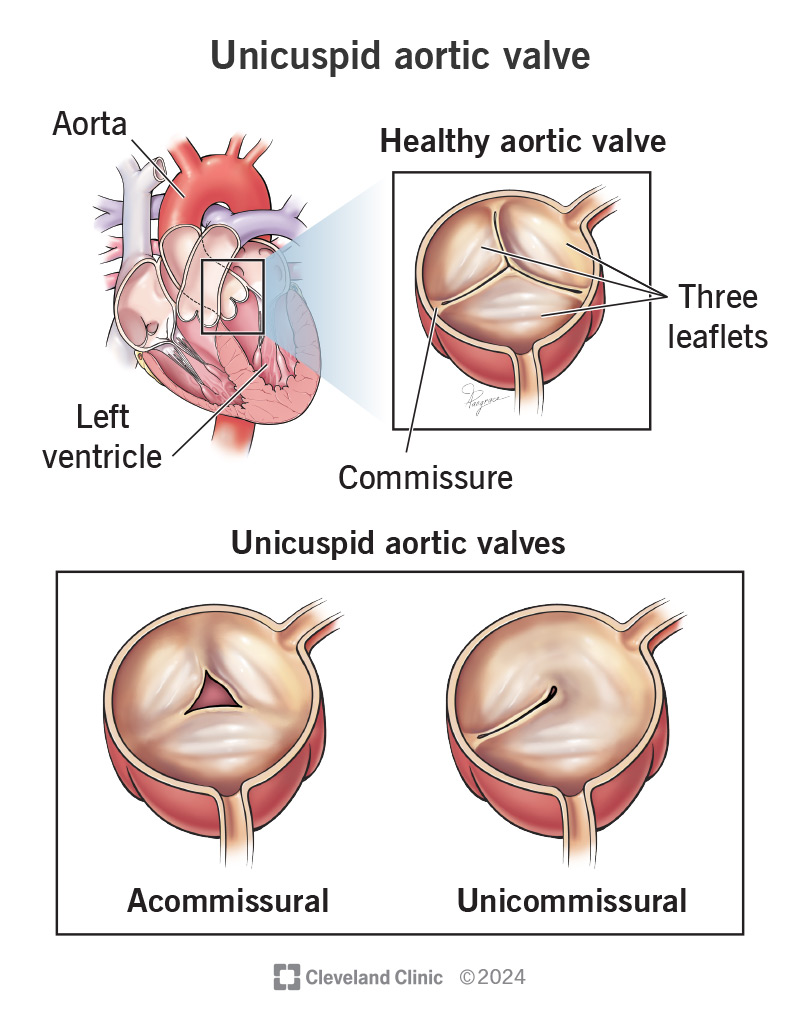A unicuspid aortic valve is a rare heart issue some people have at birth. It means you don’t have the typical three leaflets on your aortic valve. There’s only one leaflet, which leads to problems with the valve opening and closing like it should. Surgery to repair or replace the aortic valve helps people have better blood flow through it.
Advertisement
Cleveland Clinic is a non-profit academic medical center. Advertising on our site helps support our mission. We do not endorse non-Cleveland Clinic products or services. Policy

A unicuspid aortic valve is a rare heart malformation some people have at birth. Unicuspid means you have one leaflet instead of the typical three on your aortic valve. Leaflets are the flaps that open and close to let oxygen-rich blood move from your left ventricle (lower heart chamber) to your aorta. This blood flows out from your aorta to your whole body through a network of arteries.
Advertisement
Cleveland Clinic is a non-profit academic medical center. Advertising on our site helps support our mission. We do not endorse non-Cleveland Clinic products or services. Policy
People with this condition may also have other heart issues like:
Only 0.02% of the general population has a unicuspid aortic valve. It happens more often in males.
Unicuspid aortic valve disease has two types. The difference is in their commissure, or the space between where leaflets next to each other attach to the valve wall. You can think of it like your lips that are permanently attached to your face, but they can come together and separate.
The types of unicuspid aortic valve are:
Unicuspid aortic valve symptoms in adults include:
Children with this condition usually have left-sided heart failure and aren’t gaining weight like they should.
Symptoms of the acommissural type appear in babies. People with the unicommissural type don’t have symptoms until they’re adults in their 20s or 30s.
Advertisement
With unicuspid aortic valve disease, the typical three leaflets start to develop but then fuse together instead of staying separate. This happens before birth.
Researchers suspect but haven’t proven that people inherit this condition.
People with a unicuspid aortic valve can have:
A healthcare provider will listen to your heart during a physical exam. If they hear a heart murmur where your aorta is, they may want to order tests.
Tests to diagnose a unicuspid aortic valve include:
Unicuspid aortic valve treatment options for children include:
Adults usually have surgery for unicuspid aortic valve repair or replacement.
Complications of treatment may include:
It depends on the procedure you have. You may need anywhere from one week to several months to recover.
If you have unicuspid aortic valve disease, you’ll need surgery. In fact, a healthcare provider may need to repair or replace your valve more than once in your lifetime. Also, you may have other issues with your heart. And you may need to take blood thinners (anticoagulants) after surgery, depending on the type of valve you get.
A unicuspid aortic valve doesn’t correct itself. It lasts until you have surgery to fix it.
A study found that 97% of people with unicuspid aortic valve who had aortic valve surgery were alive 10 years later.
For people under 65 with a unicuspid aortic valve, getting a new prosthetic aortic valve might reduce your life expectancy by more than 10 years. This is why researchers prefer the Ross procedure for young, active people. With the Ross procedure, a provider uses your own pulmonary valve to replace your diseased aortic valve. Then they insert a pulmonary homograft (valve from a donated human heart) into the old pulmonary valve position.
After surgery, follow your provider’s instructions for taking care of your incisions (cuts). They should also tell you how long you need to rest before driving or taking on other daily activities.
Advertisement
Even if you think you’re too young for heart issues, you should see a provider if you have chest pain or trouble breathing. Once you’ve had surgery for a unicuspid aortic valve, you’ll need follow-up appointments with your provider. You may need emergency care if you have complications (like an infection) after surgery.
Questions to ask your healthcare provider may include:
Hearing that something isn’t working right in your heart isn’t easy. But over time, providers have developed treatments for a unicuspid aortic valve. Talk with your provider about what’s best for you. Because a unicuspid aortic valve is a rare condition, it’s in your best interest to find a provider who has solid experience with it. For example, researchers say a surgeon should perform at least 15 Ross procedures a year.
Advertisement
When you have aortic heart valve disease, you want the best care. Cleveland Clinic is number one in the nation for heart health. We’re ready to help you.

Last reviewed on 03/25/2024.
Learn more about the Health Library and our editorial process.